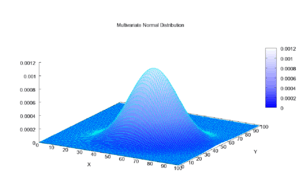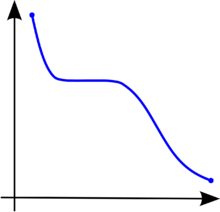Quasiconvex function
In mathematics, a quasiconvex function is a real-valued function defined on an interval or on a convex subset of a real vector space such that the inverse image of any set of the form is a convex set. For a function of a single variable, along any stretch of the curve the highest point is one of the endpoints. The negative of a quasiconvex function is said to be quasiconcave.


All convex functions are also quasiconvex, but not all quasiconvex functions are convex, so quasiconvexity is a generalization of convexity. Quasiconvexity and quasiconcavity extend to functions with multiple arguments the notion of unimodality of functions with a single real argument.
Definition and properties
A function defined on a convex subset S of a real vector space is quasiconvex if for all and we have
In words, if f is such that it is always true that a point directly between two other points does not give a higher value of the function than both of the other points do, then f is quasiconvex. Note that the points x and y, and the point directly between them, can be points on a line or more generally points in n-dimensional space.


An alternative way (see introduction) of defining a quasi-convex function is to require that each sublevel set is a convex set.
If furthermore
for all and , then is strictly quasiconvex. That is, strict quasiconvexity requires that a point directly between two other points must give a lower value of the function than one of the other points does.
A quasiconcave function is a function whose negative is quasiconvex, and a strictly quasiconcave function is a function whose negative is strictly quasiconvex. Equivalently a function is quasiconcave if
and strictly quasiconcave if
A (strictly) quasiconvex function has (strictly) convex lower contour sets, while a (strictly) quasiconcave function has (strictly) convex upper contour sets.
A function that is both quasiconvex and quasiconcave is quasilinear.
A particular case of quasi-concavity, if , is unimodality, in which there is a locally maximal value.
Applications
Quasiconvex functions have applications in mathematical analysis, in mathematical optimization, and in game theory and economics.
Mathematical optimization
In nonlinear optimization, quasiconvex programming studies iterative methods that converge to a minimum (if one exists) for quasiconvex functions. Quasiconvex programming is a generalization of convex programming.[1] Quasiconvex programming is used in the solution of "surrogate" dual problems, whose biduals provide quasiconvex closures of the primal problem, which therefore provide tighter bounds than do the convex closures provided by Lagrangian dual problems.[2] In theory, quasiconvex programming and convex programming problems can be solved in reasonable amount of time, where the number of iterations grows like a polynomial in the dimension of the problem (and in the reciprocal of the approximation error tolerated);[3] however, such theoretically "efficient" methods use "divergent-series" stepsize rules, which were first developed for classical subgradient methods. Classical subgradient methods using divergent-series rules are much slower than modern methods of convex minimization, such as subgradient projection methods, bundle methods of descent, and nonsmooth filter methods.
Economics and partial differential equations: Minimax theorems
In microeconomics, quasiconcave utility functions imply that consumers have convex preferences. Quasiconvex functions are important also in game theory, industrial organization, and general equilibrium theory, particularly for applications of Sion's minimax theorem. Generalizing a minimax theorem of John von Neumann, Sion's theorem is also used in the theory of partial differential equations.
Preservation of quasiconvexity
Operations preserving quasiconvexity
- maximum of quasiconvex functions (i.e. ) is quasiconvex. Similarly, maximum of strict quasiconvex functions is strict quasiconvex.[4] Similarly, the minimum of quasiconcave functions is quasiconcave, and the minimum of strictly-quasiconcave functions is strictly-quasiconcave.
- composition with a non-decreasing function (i.e. quasiconvex, non-decreasing, then is quasiconvex)
- minimization (i.e. quasiconvex, convex set, then is quasiconvex)
Operations not preserving quasiconvexity
- The sum of quasiconvex functions defined on the same domain need not be quasiconvex: In other words, if are quasiconvex, then need not be quasiconvex.
- The sum of quasiconvex functions defined on different domains (i.e. if are quasiconvex, ) need not be quasiconvex. Such functions are called "additively decomposed" in economics and "separable" in mathematical optimization.
Examples
- Every convex function is quasiconvex.
- A concave function can be quasiconvex function. For example is concave, and it is quasiconvex.
- Any monotonic function is both quasiconvex and quasiconcave. More generally, a function which decreases up to a point and increases from that point on is quasiconvex (compare unimodality).
- The floor function is an example of a quasiconvex function that is neither convex nor continuous.
See also
- Convex function
- Concave function
- Logarithmically concave function
- Pseudoconvexity in the sense of several complex variables (not generalized convexity)
- Pseudoconvex function
- Invex function
- Concavification
References
- Di Guglielmo (1977, pp. 287–288): Di Guglielmo, F. (1977). "Nonconvex duality in multiobjective optimization". Mathematics of Operations Research. 2 (3): 285–291. doi:10.1287/moor.2.3.285. JSTOR 3689518. MR 0484418.CS1 maint: ref=harv (link)
- Di Guglielmo, F. (1981). "Estimates of the duality gap for discrete and quasiconvex optimization problems". In Schaible, Siegfried; Ziemba, William T. (eds.). Generalized concavity in optimization and economics: Proceedings of the NATO Advanced Study Institute held at the University of British Columbia, Vancouver, B.C., August 4–15, 1980. New York: Academic Press, Inc. [Harcourt Brace Jovanovich, Publishers]. pp. 281–298. ISBN 0-12-621120-5. MR 0652702.
- Kiwiel, Krzysztof C. (2001). "Convergence and efficiency of subgradient methods for quasiconvex minimization". Mathematical Programming, Series A. 90 (1). Berlin, Heidelberg: Springer. pp. 1–25. doi:10.1007/PL00011414. ISSN 0025-5610. MR 1819784. Kiwiel acknowledges that Yuri Nesterov first established that quasiconvex minimization problems can be solved efficiently.
- Johansson, Edvard; Petersson, David (2016). "Parameter Optimization for Equilibrium Solutions of Mass Action Systems": 13–14. Retrieved 26 October 2016. Cite journal requires
|journal=(help)
- Avriel, M., Diewert, W.E., Schaible, S. and Zang, I., Generalized Concavity, Plenum Press, 1988.
- Crouzeix, J.-P. (2008). "Quasi-concavity". In Durlauf, Steven N.; Blume, Lawrence E (eds.). The New Palgrave Dictionary of Economics (Second ed.). Palgrave Macmillan. doi:10.1057/9780230226203.1375.CS1 maint: ref=harv (link)
- Singer, Ivan Abstract convex analysis. Canadian Mathematical Society Series of Monographs and Advanced Texts. A Wiley-Interscience Publication. John Wiley & Sons, Inc., New York, 1997. xxii+491 pp. ISBN 0-471-16015-6
External links
- SION, M., "On general minimax theorems", Pacific J. Math. 8 (1958), 171-176.
- Mathematical programming glossary
- Concave and Quasi-Concave Functions - by Charles Wilson, NYU Department of Economics
- Quasiconcavity and quasiconvexity - by Martin J. Osborne, University of Toronto Department of Economics